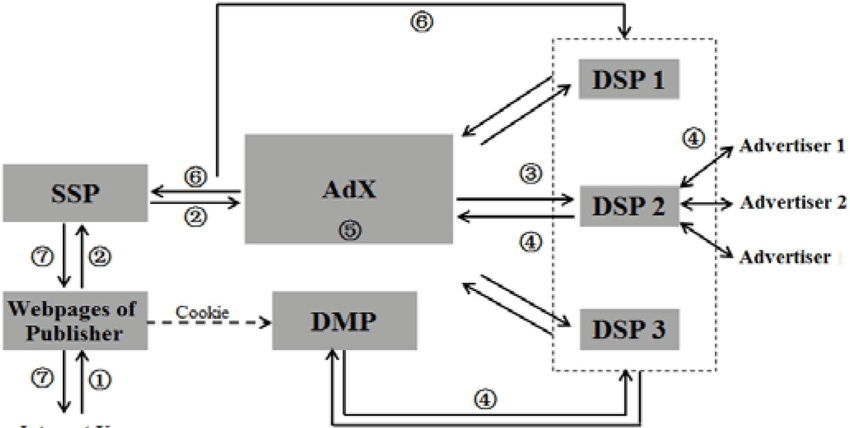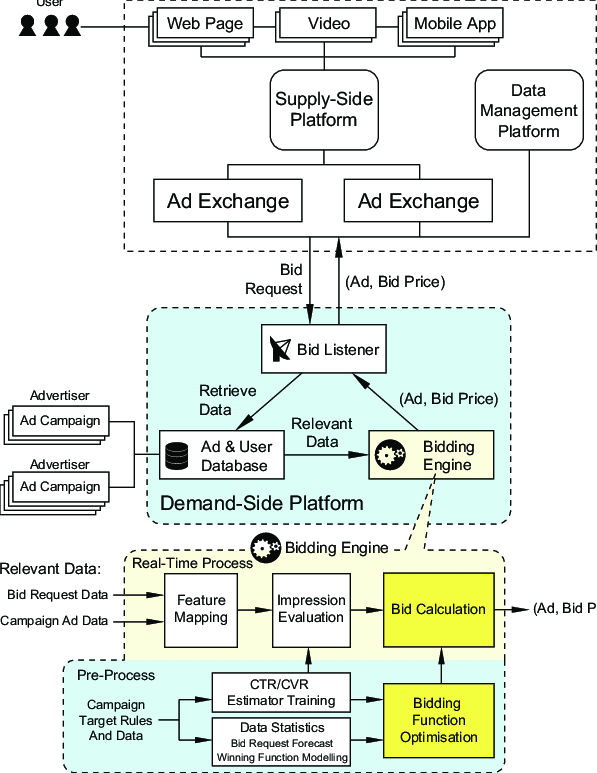
What is Real Time Bidding (RTB)?
1. Introduction of what is Real Time Bidding (RTB)
Real Time Bidding (RTB) is a technique used on the internet to enable advertisers to bid on specific ads that are being displayed on websites. RTB allows advertisers to target specific audiences and to make bids in real time as the ads are being displayed.
RTB is generally used to sell advertising space on websites. Advertisers can use RTB to find specific audiences that they want to reach, and to make bids on ads that are being displayed. The ads that are being displayed are typically those that are most likely to be engaged or clicked on.
RTB is a fast and efficient way to sell advertising space. It is also a cost-effective way to reach a large number of potential customers.
Real Time Bidding (RTB) is a form of auction in which bidders compete to place bids in real-time as the auction is taking place. This type of process is employed across a variety of industries, including retail, automotive, and pharmaceutical sectors. By enabling bidders to bid in real-time, RTB offers a more efficient, cost-effective, and transparent way of conducting auctions.
a. History of RTB
Real-Time Bidding (RTB) is a form of programmatic advertising that has been around since 2014.** It is a technology platform in which the buying and selling of digital advertising inventory is automated in real-time, based on an auction system.
RTB is an evolution of earlier technologies such as ad networks and demand side platforms (DSPs). It was initially used by large online publishers as a way to maximize their ad revenue by allowing them to auction off their inventory in real-time to a variety of buyers, such as ad networks, DSPs, and agencies.
RTB has since become the dominant form of digital advertising, and is now used by brands, agencies, and publishers alike. It has allowed buyers to target individual users with more precision, while also giving publishers more control over the types of ads they display. Its success has been driven in part by the rise of programmatic advertising, which has allowed buyers to automate the buying and selling of advertising inventory.
2. Benefits of RTB
Right-to-be-forgotten (RTB) is a process that allows individuals to request that certain personal information be removed from search engines and other online platforms. RTB can provide a number of benefits for both publishers and advertisers, including cost efficiency, increased reach and advanced targeting, transparency, increased controls, accuracy, and the benefits of automation.
a. RTB is cost efficient
Real Time Bidding (RTB) offers a cost-effective solution for both advertisers and publishers, allowing advertisers to acquire a high volume of impressions at an affordable price, and publishers to drive a large amount of traffic without having to invest in finding expensive ad campaigns. This results in a more efficient market and greater profits for both parties.
b. Reach & Targeting
There are a number of advantages to using reach and targeting in RTB. First, it allows you to target a specific audience with your ads, which can result in a higher click-through rate (CTR) and more conversions. Additionally, by targeting specific demographics, you can ensure that your ads are seen by the right people and that you are not wasting your time and money on ads that no one will see. Finally, by using reach and targeting, you can ensure that your ads are seen by the people who are most likely to be interested in your product or service.
c. Transparency & Advanced Control of Settings
Transparency is one of the key advantages of using RTB. It allows marketers to see all the data that is being collected about them and to make informed decisions about their ad campaigns. This control also allows marketers to be more selective about which ads they show to which audiences, which can lead to more targeted campaigns.
d. Accuracy & Automation
There are many advantages to accuracy and automation of RTB. First and foremost, these processes can help to improve the accuracy and consistency of ad targeting. This can lead to more effective ad campaigns and increased ROI. Additionally, automation can help to reduce the amount of time that is spent on manual tasks, which can free up valuable resources that can be put towards more strategic initiatives. Finally, automation can help to ensure that ad campaigns are executed in a timely and consistent manner, which can ensure that the most relevant ads are reaching the right audience.
3. Economy of RTB
According to marketsandmarkets.com research, 8 years since its introduction, the global Real-Time-Bidding (RTB) market is expected to skyrocket from USD$6.6 billion in 2019 to USD$27.2 billion by 2024, at a Compound Annual Growth Rate (CAGR) of 32.9%. The online advertising market is expected to experience a significant growth, rising from USD 304.0 billion in 2019 to USD 982.82 billion by 2025.
Source: https://www.marketsandmarkets.com/Market-Reports/real-time-bidding-market-4630735.html

4. How Does RTB Work?
RTB is a technique used by publishers to target ads to users based on their past behavior on the publisher’s website. Publishers use RTB to identify users who have visited their website in the past and then serve them ads based on those past visits. This allows publishers to generate more revenue from ads served to users who are likely to be interested in the content they offer.
a. Process Overview
The RTB process is a vital part of the display advertising ecosystem and enables ad networks, exchanges, and publishers to auction off space on their websites and apps.
The RTB process begins with an ad network submitting a request to an exchange for ad space. The exchange then places the ad request with a variety of ad networks and exchanges, which compete for the ad space. The ad is then served to website visitors and app users. The publisher receives a share of the ad revenue generated from the ad.
b. Bidding Mechanism
The RTB bidding mechanism is a way for publishers to auction off ad space on their websites. It works like this: Publishers create ad spaces on their websites and set a price for each space. Advertisers then bid on the ad space, and the publisher decides which advertiser to give the space to.

5. Challenges of RTB
There are several challenges that RTB agencies face when implementing RTB programs. One of the biggest challenges is ad fraud. Ad fraud occurs when fraudulent actors use fake clicks and impressions to make money. This can be a big problem because it can cost agencies a lot of money. Additionally, privacy concerns are often raised when it comes to using RTB. Some people feel that their personal information should not be shared with advertisers. Finally, agencies often lack control over their RTB campaigns. This is because they are not in control of the ads that are shown to users.
a. Ad Fraud
The RTB challenge of Ad Fraud is a growing problem in the digital advertising industry. Ad Fraud is the deliberate attempt to distort the performance of digital ads by injecting invalid traffic. This can be done through a variety of methods, including the use of bots, fake clicks, and fake impressions.
The RTB challenge of Ad Fraud is a growing problem in the digital advertising industry. Ad Fraud is the deliberate attempt to distort the performance of digital ads by injecting invalid traffic. This can be done through a variety of methods, including the use of bots, fake clicks, and fake impressions.
This problem has serious implications for both publishers and advertisers. Advertisers lose money when their ads are shown to users who are not actually interested in the product or service being advertised. Publishers also suffer when their ads are shown to users who are not actually interested in the content being offered.
To combat this problem, ad networks and publishers need to implement effective fraud detection measures. These measures can include the use of cookies, browser fingerprinting, and other tracking technologies. They can also include the use of human reviewers to check the validity of traffic.
b. Privacy Concerns
There are a few potential privacy concerns with RTB. For example, if an advertiser is able to target ads specifically to users based on their interests, this could potentially reveal personal information about those users. Additionally, RTB could allow advertisers to collect data about users’ browsing habits and preferences without their consent or knowledge. If this data is then used to target ads specifically to those users, it could be an invasion of their privacy.
c. Lack of Control over Choosing Ads
In recent years, RTB (real-time bidding) has become increasingly popular in the advertising space. RTB allows advertisers to bid on specific ad space in real-time, based on a set of criteria such as time of day, day of the week, or location. This type of bidding allows for more accurate targeting of ads and can lead to more efficient spending.
However, there is a lack of control over how RTB affects the advertising market. Advertisers are not always able to know which ads are being shown to which consumers, which can lead to wasted ad spend and decreased consumer engagement. Additionally, RTB can create a bidding war between different advertisers, which can result in decreased ad quality and increased advertising costs that would be beneficial for the publishers. Nonetheless, RTB platforms offer category filters and domain or URL blocking to increase the control over which ads to be shown.
6. Conclusion
The role of RTB in online advertising continues to grow in importance as more and more consumers turn to the internet to find information and purchase products and services. There are many benefits to using RTB, including the ability to more accurately target ads to specific users, increase click-through rates (CTRs), and better understand customer behavior. However, there are also some challenges that need to be addressed, such as the potential for fraud and abuse. Overall, RTB is an important tool for online advertisers, and continues to grow in popularity.
a. Overview of RTB
The RTB (Real-Time Bidding) is an effective online advertising strategy that enables advertisers to bid on ad space and target specific demographics and interests in real-time. This type of advertising provides advertisers with the ability to measure the effectiveness of their campaigns quickly and accurately. Furthermore, RTB allows for greater targeting and optimization of ad campaigns, resulting in improved ROI.
b. Benefits & Challenges of RTB
Retail tracking and attribution (RTB) is a powerful marketing tool that allows marketers to understand how their ads are performing and to optimize their campaigns accordingly.
There are a number of benefits to using RTB, including the ability to identify and target potential customers more effectively, and the ability to measure the effectiveness of your advertising campaigns.
However, RTB also has a number of challenges, including the difficulty of measuring the performance of individual ads, and the potential for fraud, and less control on choosing individual ads. Yet, there are category filters as well as domain or URL blocking features.
Overall, RTB is a powerful marketing tool that can help you to more effectively target your customers and to measure the effectiveness of your advertising campaigns, though it may also be challenging, and there is potential for fraud.
FAQ
Real-time bidding (RTB) is an online advertising process that allows online publishers and advertisers to bid on ad impressions in real-time. This process allows advertisers to bid on ad impressions as soon as they become available, which allows them to optimize their campaigns and target specific audiences in a much more efficient manner than traditional methods. RTB also enables publishers to obtain the best price for their ad inventory and increases their ad revenue.
For publishers, real-time bidding (RTB) provides a number of benefits including:
• Increased competition and pricing power in the marketplace that will lead to increased revenue
• Access to higher quality and more targeted ad inventory
• Improved fill rates and increased revenue
For advertisers, RTB provides:
• Increased control over ad spend
• Access to higher quality ad inventory
• Increased targeting capabilities
• Improved performance tracking and optimization
• Reduced media costs and improved ROI
Real-time bidding (RTB) is an automated process in which advertisers bid on ad impressions in an auction-based system. To participate in RTB, an advertiser must set up an account with a real-time bidding exchange, such as Google Ad Exchange or Xandr, where they can select an ad inventory from a variety of sources. The exchange then runs an auction to determine which advertiser will win the impression. The winning advertiser pays the exchange for the impression, and the exchange pays the publisher who owns the inventory. This system enables advertisers to target the most valuable consumers at the lowest possible cost.
Real-time bidding is also commonly referred to as a subcategory of programmatic advertising, programmatic buying, or programmatic media buying.
Real-time bidding (RTB) occurs in an automated auction-style process through a programmatic ad exchange. The process takes place in real-time, typically within milliseconds, and advertisers can bid on individual impressions of an advertisement in a bidding war. This bidding process occurs across multiple ad exchanges and in different markets, including mobile, display, and video.
DSP bidding engine. Source: Optimal Real-Time Bidding for Display Advertising – Scientific Figure on ResearchGate. Available from: https://www.researchgate.net/figure/An-illustration-of-a-demand-side-platform-and-its-bidding-engine-in-RTB-display_fig1_264397624 [accessed 10 Dec, 2022]






